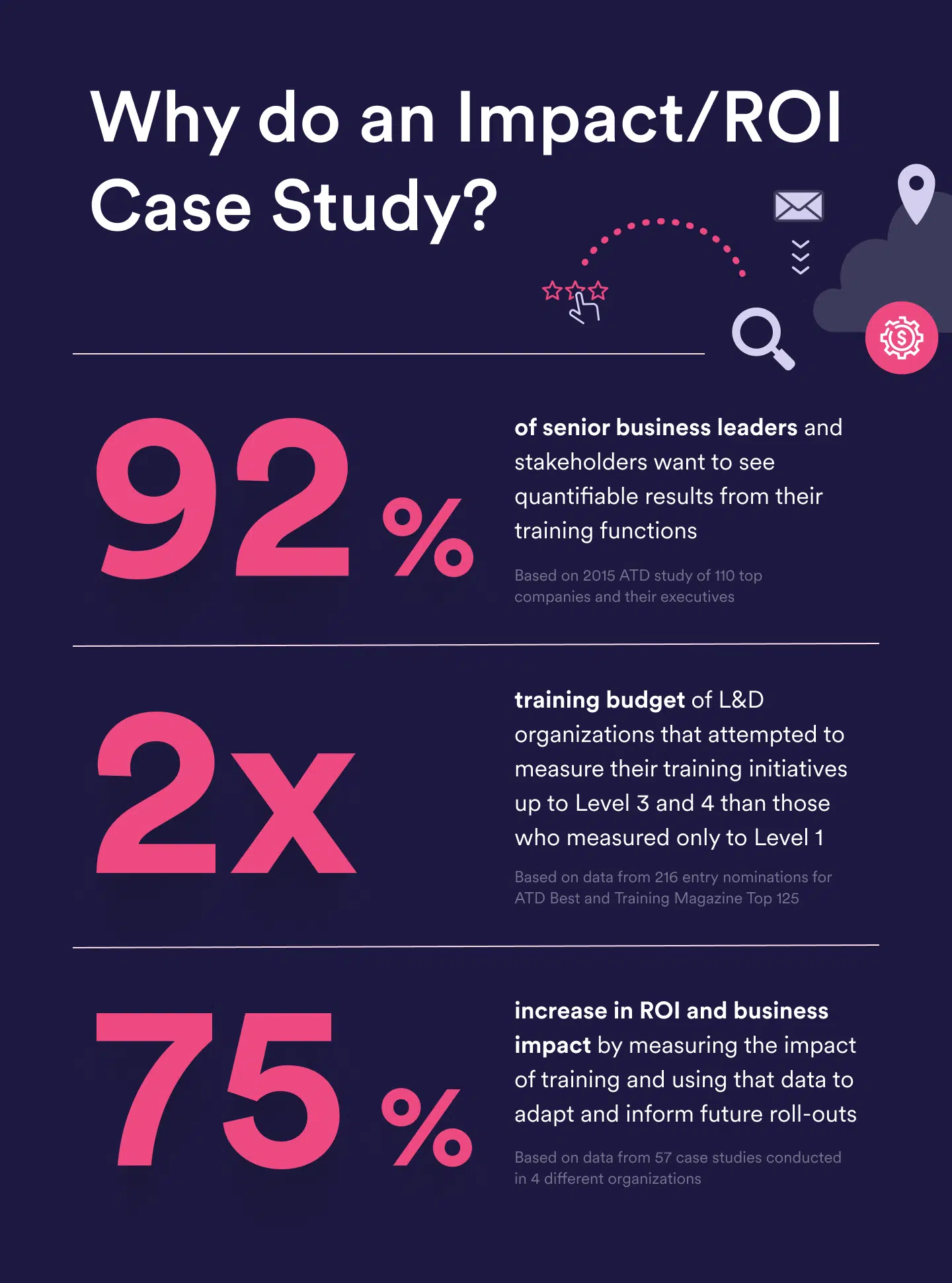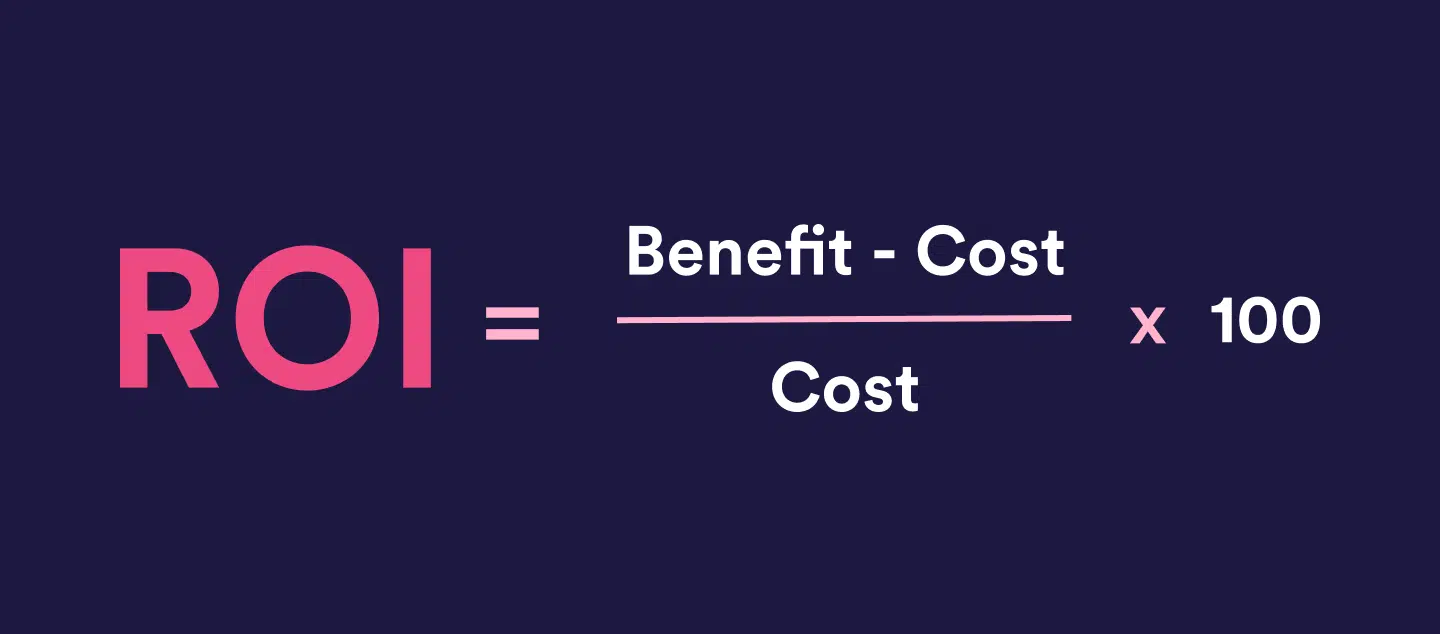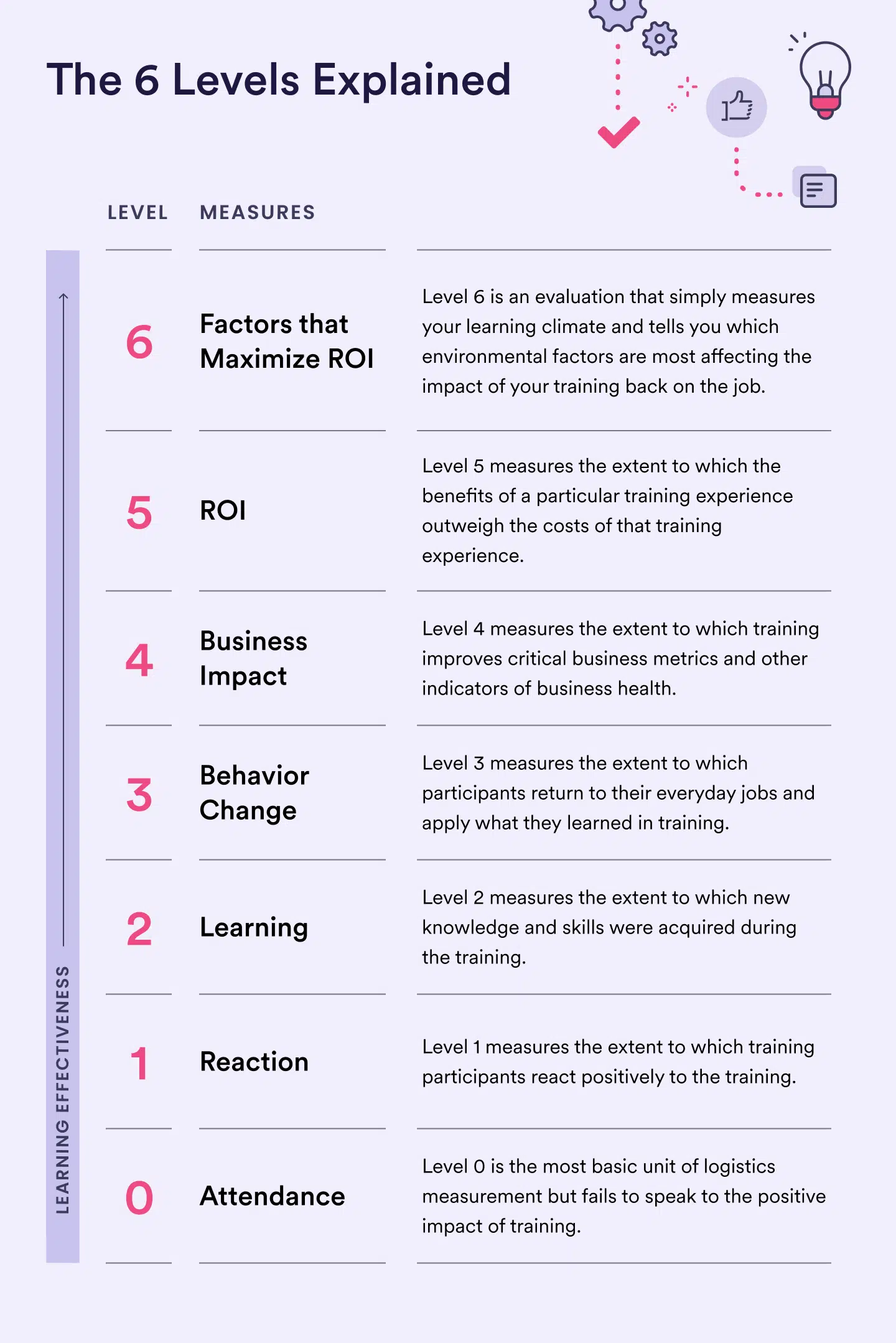Are you curious about measuring L&D team performance and understanding the best ways to calculate ROI for training programs? An easy way to spot a high-performing learning and development team is to dive into their strategy for evaluating and defining success for each program, department and the impact on each individual.
Empowering managers and leaders with practical tools and a KPI scorecard allows for clear expectations and feedback sessions throughout each training exercise or process. Here are ways we see industry leaders build an effective training program evaluation strategy.
How to Build an Evaluation Strategy for Your Training Program
You’ve put in the effort and investment to find ways to educate and engage with your workforce. But, without assigning key milestones, feedback sessions, and goals, you won’t get a clear picture of the impact on your L&D training or find ways to improve. Evaluating your training programs is to get a feel for what is working, identify opportunities, and define metrics that show your progress in meeting training goals.
An Outline for Evaluating Your Training Programs
Before jumping into the implementation phase, consider a few factors first. To start, you need to identify the critical stakeholders for each training. Naming each participant, their roles, and primary accountabilities are crucial for visibility and communicating expectations by function. This also helps others know what they are being asked to do or report during each training process.
Top Stakeholders in Training Evaluation
- Organizational Leadership Team
- Instructors / Coaches / Facilitators
- Managers / Departmental Leaders
- Direct Reports / Employees / Trainees
Understanding each stakeholder’s point of view will provide a comprehensive and objective evaluation of your learning sessions. Everyone plays a part in the continuous learning process within your organization. Supporting one another, buying into individual development, giving clear direction, and understanding your team’s educational needs are all important factors that various stakeholders provide.
Ultimately, your L&D team will be held responsible for effective training by an organizational leadership team, board of directors, or similar group. Having measurable results is the easiest way for you to show your impact. A recent study showed that 92% of senior business leaders and stakeholders want quantifiable results from their training functions, but only 9% of internal L&D teams show them anything. Remain in step with leadership by sharing the same terminology and performance checkpoints in your evaluation strategy.
Identify Your Training KPIs Before Starting Each Learning Program
Before each training, define and communicate the measurable values that show how well you meet your training objectives. Get creative; the term KPIs might be overused in your company. Are there other motivating words you can use instead to inspire your team? Think about some of your core values and ways to incorporate these, but stick to them for consistency across the organization.
Your KPIs represent actions and moments that align with achieving your goal. They should be time-based and specific enough to avoid ambiguity and confusion. For example, company-wide, your team may want to achieve X number average for your employee training satisfaction scores. To accomplish this, key indicators will be along the way to track success.
Maybe your team needs to get better at providing internal resources. So, your first KPI is to select and implement an LMS software by [date]. Next, you want X amount of employees to complete the first three pieces of training by Q1. To go further, it could be helpful to have a quick knowledge test to score how well employees retain information. A KPI could be having an X average across the board on your training quizzes. This shows that your L&D group is working hard to provide resources and information in ways that support team learning.
Ultimately, these KPIs should contribute to your team’s training satisfaction scores (your overall goal). Of course, you can update core metrics or definitions for success over time. Still, these are excellent ways to quantify your training effectiveness and ROI for the LMS investment.
Need another example? You’re in luck! We’ve helped many companies with their training efforts. Check this one out. Case Study → Hone Inspires Zola to Create Behavioral Change with Each Direct Report— check it out below.
Using Analytics and Check-ins During Training Program Evaluation
Are there specific target metrics you are looking to hit throughout your training process? If not, now might be a good time to set these goals with your team. It could be a little early in the process, maybe you don’t have enough data, or the team has scaled significantly. No matter the case, you can adjust quantifiable data based on industry averages, insight from peers, or help from an independent source.
The more data and analytics you can show in your training program evaluation strategy, the easier it is for decision-makers to understand better if your investments and efforts are paying off, need an adjustment, or require more clarification. Data analytics can help us track progress over time and see how similar companies can stack up in comparison. Interpreting training analytics impacts understanding of company culture, growth opportunities and even as a value measurement for outside investors.
L&D leaders utilize technology to showcase and track progress on their training program evaluation methods. Creating a model for specific inputs and outputs for your company goals allows you to easily manage and show progress and improvement actions to sustain an effective training strategy. Once enough data is gathered, you can benchmark over time, see what areas your team should focus on, and where scores and measurables can be updated.
Create Feedback Loops in Your Training Programs
Qualitative data can only take you so far. You’ll need commentary, healthy debate, and problem-solving to accomplish your training objectives. This only happens when you’ve built in a system or standard time(s) to gather feedback from stakeholders during your learning initiatives.
Feedback loops help ensure that communication standards are transparent and available at all levels. Because individual learning styles vary, it’s essential to ask how each person consumes information and ways to alter or refine your training styles or systems of continued learning. If this is new for your leadership team, give them a quick refresher on current management trends in connecting with each direct report.
Providing input opportunities promotes fairness and leads to more buy-in from your team, even when some particular training might be challenging, uncomfortable, or a new experience for each participant. Ultimately, you will not know how well things are going if you don’t ask.
While all recommendations should be taken seriously, depending on the stakeholder or training leader, final decisions are made at the discretion of those with the highest accountability levels for achieving the training goal.
Evaluating Training Program Performance
A good training program should work backward from the intended outcome you’ve set for the future. That way, you’ve identified relevant KPIs, provided feedback opportunities, and moved into the last evaluation phase – calculating your ROI and reporting your findings.
Calculating the ROI of training programs does not have to be too complicated. This can be a challenge for many teams, but with the proper framework, you can easily apply a formula and identify where to continue to focus time, investment, and energy.
Training and Development ROI Equation
To better understand the impact of training, there are a few levels that are commonly used and incorporated into an evaluation strategy. These levels help explain engagement factors that can be analyzed to show success or ways to improve your programs.
Levels of Training Evaluation and Impact
Curious to learn more about each of the levels? Check out our blog, 6 Ways to Measure the ROI of Training and Development. An evaluation strategy helps measure the strength of the elements involved in the six levels. Once you understand where your team falls within each group, you can report what you’ve learned between L&D and your leadership team.
Present Your Training Evaluation Strategy Findings to Leadership
Showing your data and performance outcomes with your leadership team should not be scary if you’ve done the work to be on the same page before starting each training session. Of course, each organization needs to know if funds are being issued and used wisely. Do your best to keep the business impact and agreed upon training outcome at the forefront of your conversations.
This way, your stakeholders know that you’ve put thought and care into ensuring that your training program was set up for success and to achieve your end goals. Often, these new training initiatives take place in times of rapid team growth, company transition (potentially M&A or other), or restructuring of company priorities.
There are many accountability measures and new tasks your L&D team will take on this year. To build confidence and synergy, be sure to find solutions that fit your evaluation strategy and support your team. Hone provides many valuable resources for teams to get on the right path.
Check out our latest eBook – Investing in Your Future: How to Measure the ROI of Manager Training Programs eBook to learn how to create an evaluation strategy for your team’s performance.
















